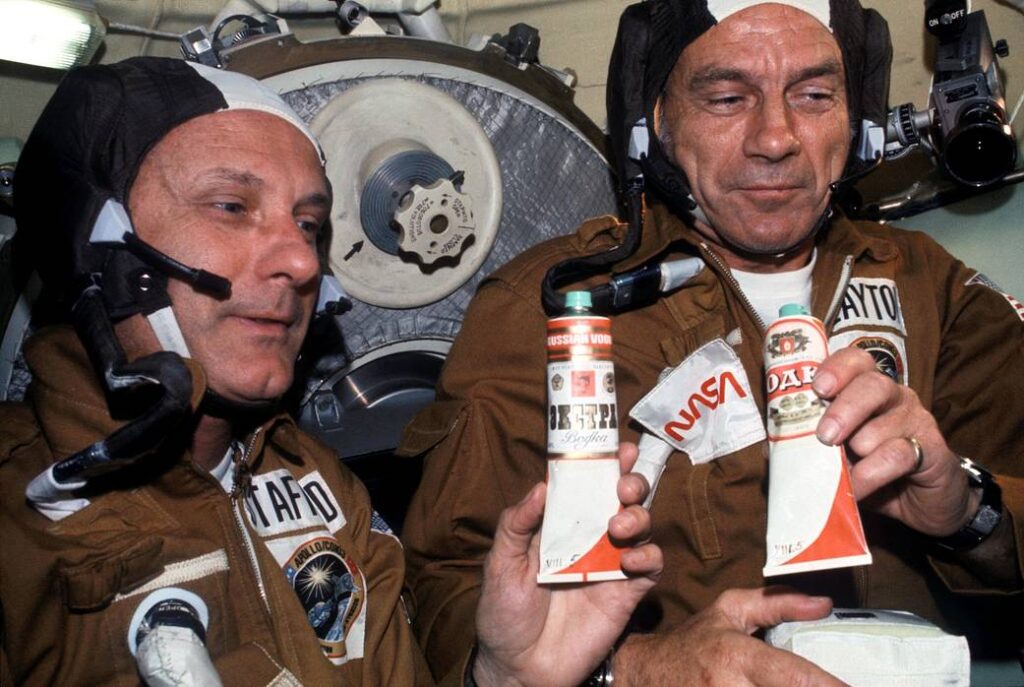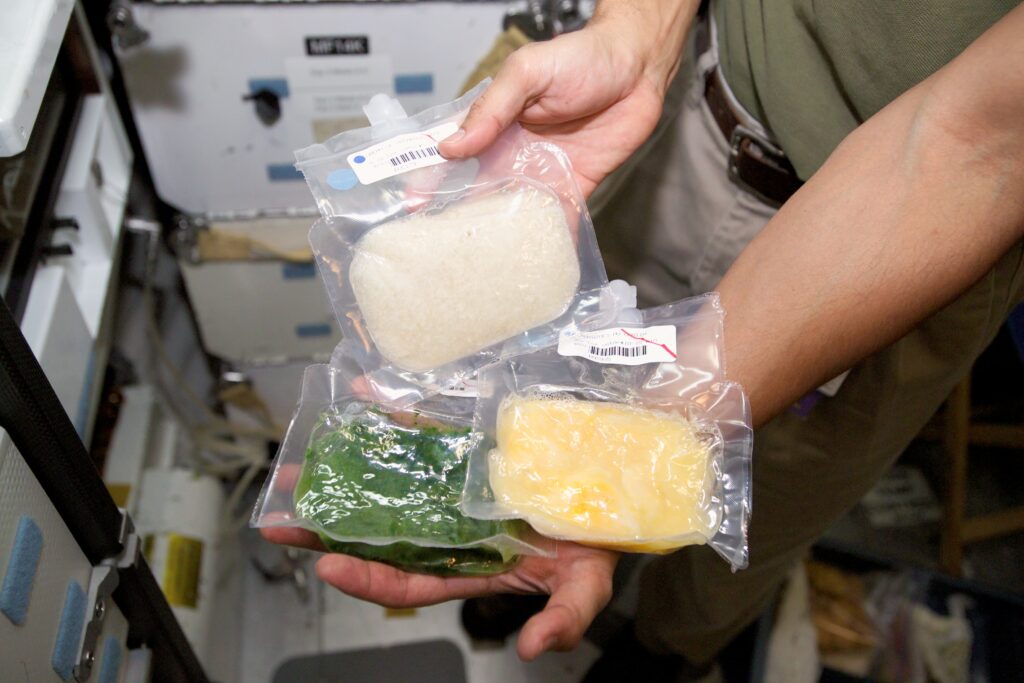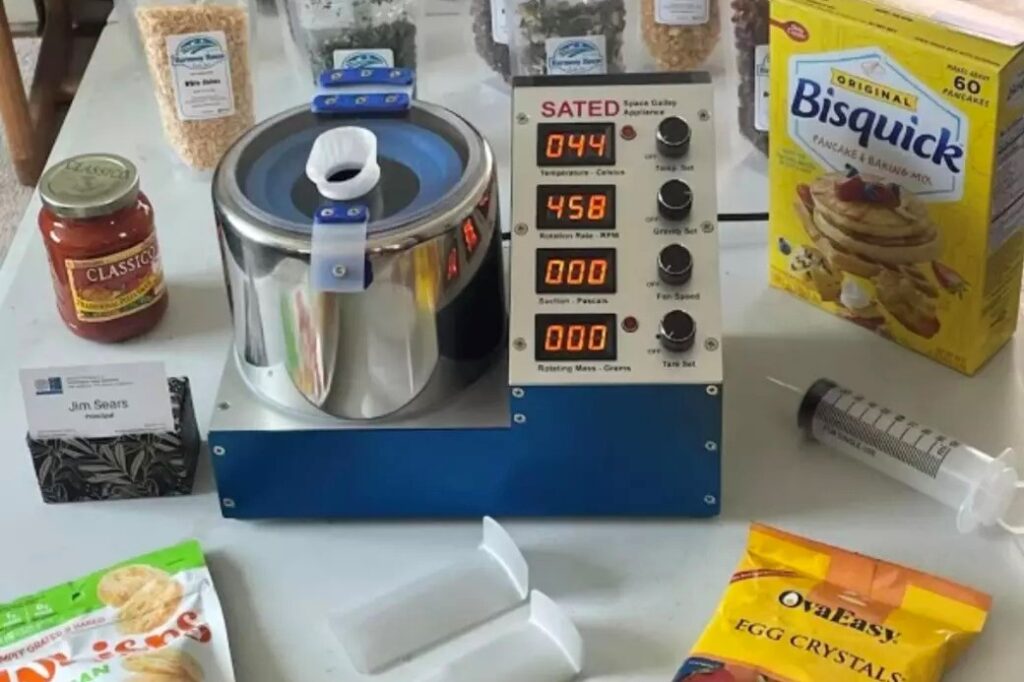When we think about sitting down to a meal in space, we tend to conjure up images of bland freeze-dried powders and strange tubes of semiliquid.
However, space food has much improved over the decades and now astronauts can enjoy a meal more in keeping with what we might expect back on planet Earth.
From the moment the first human stepped into space, the quest to provide adequate nourishment for astronauts has been a constant challenge and a source of innovation.
Have you ever wondered what it would be like to experience breakfast in space? Or perhaps you have always wanted to know what it would be like to make dinner in orbit?
AeroTime takes a look at the history of space food and what astronauts might be able to expect from the future of space travel.
Freeze-dried food and a ban on alcohol
“The main thing is that there is sausage, to go with the vodka,” Russian cosmonaut, and first person in space, Yuri Gagarin said moments before the Vostok 1 rocket took off for the first manned space flight in human history on April 12, 1961.
During the flight, Gagarin was sustained by 63 aluminum tubes filled with food, at 160 grams each, bread balls, smoked sausage, and lemon slices. It was crucial to have sufficient resources in case he encountered any complications that could potentially leave the rocket stranded in space.
About 28 minutes after reaching the orbit, Gagarin made history once again after enjoying a meal of beef and liver paste squeezed from an aluminum tube, followed by a second tube containing a chocolate dessert.
Although the Soviet astronaut was probably not that hungry as the mission only lasted for 108 minutes (about two hours), his meal confirmed that the digestive system functioned effectively without gravity’s pull, marking a significant milestone in space exploration.
While there was no actual vodka to go with the sausage during the first-ever space flight, Soviet astronauts did experiment with the effect of alcohol in later missions.
“During prolonged space missions, especially at the beginning of the Space Age, we had alcoholic drinks in the cosmonauts’ rations,” cosmonaut Alexander Lazutkin, who spent time aboard Russia’s Mir space station, told NBC news in 2010. “This was cognac, which the doctors recommended for use. We used it to stimulate our immune system and on the whole to keep our organisms in tone.”
However, when the International Space Station (ISS) was established on November 20, 1998, NASA maintained a long-standing policy prohibiting the consumption of alcohol on board. The ban was based on the potential negative effects alcohol can have on astronaut performance, health, and safety in the unique environment of space.

Nutritional challenges
Aside from alcohol, there are many other challenges when eating and drinking in low-gravity conditions.
“On the ground, we liked the sweet fruit juices, such as mango. In orbit we generally found them too sweet,” NASA astronaut Colonel Glenn told the New York Times on January 16, 1985.
According to NASA, in space, astronauts face changes in sense of taste and smell due to fluid redistribution. Upon arriving at the ISS, many astronauts report a sensation of congestion in their heads and sinuses, like a cold. Supplies must be carefully packaged and preserved to ensure nutrition and flavor.
The cut from the natural force of gravity means that food and liquids cannot be consumed as they would be on Earth. Rather, astronauts must contend with pouches, tubes, and specially designed containers that prevent crumbs, droplets, or floating morsels from contaminating the spacecraft’s delicate equipment or clogging air filters.
A story about the US astronaut John Young sneaking a corned beef sandwich on board the Gemini 3 mission in 1965 has become part of space folklore. However, Deke Slayton, head of the NASA’s Astronaut Office at the time, clarified that he had been aware of the sandwich but Young had only taken a quick bite before safely stowing it away.
At the beginning of the Space Age, astronauts would only consume puree squeezed from tubes and cubes of dry food. Later, NASA’s Apollo program, which spanned from 1961 to 1972, started the transition from tubes to more solid food items. However, the meals were still unappetizing and lacked flavor.
“No one goes to space for the food…but the views are amazing,” US astronaut Don Thomas, who flew shuttle missions in the 1990s, told All About Space magazine, as reported by its sister publication Space.com in 2022 article. “Space food is a lot like camping food. It’s freeze-dried or irradiated,” he added.
A decade later, in 2006, US celebrity chef Emeril Lagasse collaborated with NASA to bring an elevated era of culinary delight to astronauts during the launch of the Space Shuttle Discovery. While the Meals, Ready to Eat (MREs), also used by the US Army (USA), were still on board, they offered improved taste, texture, and options.
Lagasse’s innovative menu included dishes like mashed potatoes with bacon, flavorful jambalaya, and, since alcohol is not allowed in space, a rum extract-infused bread pudding.
The updated meals were enjoyed by astronauts on the ISS from August 2006.

The social aspect of space meals
Sharing meals has long been a cherished social ritual, fostering a sense of camaraderie and connection. In recognition of the importance of this aspect, astronauts are provided with designated dining areas where they can gather and enjoy meals together, forging bonds and combatting the isolation that can accompany long-duration space missions.
Even astronauts from different nations usually come together on the ISS and share dishes from their respective countries, promoting camaraderie through culinary diplomacy. For instance, Japanese Aerospace Exploration Agency (JAXA) brings rehydratable noodles, while the Italian Space Agency (ASI) introduced the ISSpresso, a coffee machine tailored for space, which allowed astronauts to enjoy the first-ever espresso coffee in space.
“Food on the ISS is sort of an example of the many cultures that come and live on the International Space Station,” NASA astronaut Sunita Williams, whose father immigrated to the US from India, told the SciTechDaily in May 2022. “When I realized that there were Indian dishes on the standard menu, I was pretty excited because this is something that I’ve eaten for my whole life, grew up with, in particular, reminds me of when I was a kid and at home with my family.”
Additionally, automated resupply spacecraft, such as the European Space Agency’s “Automated Transfer Vehicle” launched in 2008 and Russia’s “Progress” launched in 2000, dock the ISS every couple of months, delivering fresh fruit, water, and pre-packaged meals to the crew.
The multicultural astronauts also benefit from both US and Russian heating systems for their food on the ISS. The American system relies on hot water and plastic pouches, while the Russian system uses cans of food heated in compartments inset into the galley.
In 2001, Russian cosmonaut Yuri Usachov even bought a Pizza Hut pizza on board the ISS, becoming the first astronaut to eat a slice in space.
However, astronauts could soon be able to cook a pizza in space themselves.
Could there be a pizza party on the ISS?
On May 19, 2023, NASA announced that space engineering company Ascent Technology, along with seven other participants from the US, Australia, Sweden, and Finland were the finalists of its Deep Space Food Challenge.
Launched with the Canadian Space Agency, the competition aims to address the challenges astronauts encounter during long-duration space missions and encourage the development of novel food production technologies or systems.
Astronauts experience up to 20% muscle mass loss on spaceflights lasting five to 11 days, making an adequate diet crucial for combating the effects of muscle atrophy.
Ascent Technology took a distinctive approach by introducing a zero-gravity, centrifugal oven enabling astronauts to cook a variety of delectable dishes, including pizza, entirely from scratch during space missions.
The innovative SATED (Safe Appliance, Tidy, Efficient, Delicious) oven is slightly larger than a toaster. Functioning like a washing machine, it houses cooking ingredients in a spinning cylinder warmed by positive temperature coefficient (PTC) heaters, much like those found in space heaters, hair dryers, and medical equipment.
The machine allows astronauts to craft their own meals by injecting ingredients through a central hole in the cylinder. They can add an array of elements one by one, adjusting the cooking temperature and time as needed.
“The ability to cook, serve, and gather around good meals is a necessity of human life that will become essential for sustainably colonizing space,” said the founder of Ascent Technology, Jim Sears. “Being able to eat a genuine crispy, cheesy, tomatoey piece of pizza on the surface of the moon, or on the way to Mars, means you could actually be inspired to be there.”
NASA’s Artemis program plans to return to the Moon by 2024 and send astronauts to Mars by 2040. Private space companies are also ushering in a whole new movement by turning space into a tourist destination. With SATED, which Sears expects to be ready by 2025, a variety of meals could be offered on upcoming space explorations.

Beyond the ISS: what is the future of space food?
NASA’s future plans also include growing plants in space for more sustainable food production on long-duration missions, including potential lunar and Martian colonies. This will reduce reliance on Earth supplies and allow for the allocation of cargo space to other essential materials.
New York-based Air Company, a carbon utilization specialist, has even offered a system designed to utilize the carbon dioxide expelled by astronauts in space to produce alcohol, which could then be utilized to cultivate edible food. The company already develops alcohol from CO2 for plane fuel and perfume.
Sucking liver mash from a metal tube in the vast emptiness of space was a testament to human ingenuity, adaptability, and the relentless pursuit of exploration.
As humans continue to push the boundaries of space exploration, the culinary frontier will also play a vital role, ensuring that meals not only sustain astronauts’ bodies but also introduce the true comfort and joy of eating.

